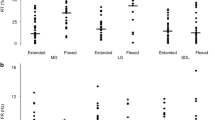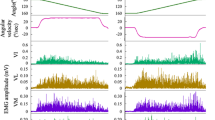Abstract
The present study was designed to determine the relative contribution of the gastrocnemius muscle to isometric plantar flexor torque production at varying knee angles, while investigating the activation of the gastrocnemius muscle at standardised non-optimal lengths. Voluntary plantar flexor torque, supramaximally stimulated twitch torque and myoelectric activity (EMG) from the triceps surae were measured at different knee angles. Surface and intra-muscular EMG were recorded from the soleus muscle and the medial and lateral heads of the gastrocnemius muscle in 10 male subjects. With the ankle angle held constant, knee angle was changed in steps of 30° ranging from 180° (extended) to 60° (extreme flexion), while voluntary torque from a 5-s contraction was determined at 10 different levels of voluntary effort, ranging from 10% of maximal effort to maximal effort. To assess effort, supramaximal twitches were superimposed on all voluntary contractions, and additionally during rest. Maximal plantar flexor torque and resting twitch torque decreased significantly in a sigmoidal fashion with increasing knee flexion to 60% of the maximum torque at 180° knee angle. For similar levels of voluntary effort, the EMG root mean square (RMS) of gastrocnemius was less with increased knee flexion, whereas soleus RMS remained unchanged. From these data, it is concluded that the contribution of gastrocnemius to plantar flexor torque is at least 40% of the total torque in the straight leg position. The decrease of gastrocnemius EMG RMS with decreasing muscle length may be brought about by a decrease in the number of fibres within the EMG electrode recording volume and/or impaired neuromuscular transmission.
Similar content being viewed by others
References
Arendt-Nielsen L, Gantchev N, Sinkjaer T (1992) The influence of muscle length on muscle fibre conduction velocity and development of muscle fatigue. Electroencephalogr Clin Neurophysiol 85(3): 166–172
Belanger AY, McComas AJ (1981) Extent of motor unit activation during effort. J Appl Physiol 51(5): 1131–1135
Bigland-Ritchie BR, Furbush FH, Gandevia SC, Thomas CK (1992) Voluntary discharge frequencies of human motoneurons at different muscle lengths. Muscle Nerve 15:130–137
Fugl-Meyer AR, Sjöström M, Wählby L (1979) Human plantar flexion strength and structure. Acta Physiol Scand 107:47–56
Fukunaga T, Ror RR, Shellock FG, Hodgson JA, Day MK, Lee PL, Kwong-Fu H, Edgerton VR (1992) Physiological cross-sectional area of human leg muscles based on magnetic resonance imaging. J Orthop Res 10:926–934
Gandevia, SC, McKenzie DK (1988) Activation of human muscles at short muscle lengths during maximal static efforts. J Physiol (Lond) 407:599–613
Grieve DW, Pheasant S, Cavanagh PR (1978) Prediction pf gastrocnemius length from knee and ankle joint posture. In: Asmussen E, Jörgensen K (eds) Biomechanics VI-A. University Park Press, Baltimore, pp 405–412
Heckathorne CW, Dudley MS, Childress S (1981) Relationships of the surface electromyogram to the force, length, velocity, and contraction rate of the cineplastic human biceps. Am J Phys Med 60(1):1–19
Herman R, Bragin SJ (1967) Function of the gastrocnemius and soleus muscle. Phys Ther 47(2):105–113
Herzog W, Read LJ, Keyrs HEdJ (1991) Experimental determination of force-length relations of intact human gastrocnemius muscles. Clin Biomech 6:230–238
Lewis DM, Luck JC, Knott S (1972) A comparisson of isometric contractions of the whole muscle with those of motor units in a fast-twitch muscle of the cat. Exp Neurol 37:68–85
Loeb GE, Gans C (1986) Design and construction of electrodes. In: Loeb GE, Gans C (eds) Electromyography for experimentalists. University of Chicago Press, Chicago, pp 109–119
Lindström LH, Magnusson RI (1977) Interpretation of myoelectric power spectra: a model and its applications. Proc IEEE 65: 653–622
Lännergren J, Westerblad H (1986) Force and membrane potential during and after fatiguing continuous high-frequency stimulation of Xenopus laevis muscle fibres. Acta Physiol Scand 128: 359–368
Murray MP, Guten JM, Baldwin JM, Gardner GM (1976) A comparison of plantarflexion torque with and without the triceps surae. Acta Orthop Scand 47:122–124
Rack PMH, Westbury DR (1969) The effects of length and stimulation rate on tension in the isometric cat soleus muscle. J Physiol (London) 204:443–460
Ralston HJ, Libet B (1953) Effect of stretch on action potential of voluntary muscle. Am J Physiol 173:449–455
Sale D, Quinlan E, Marsh E, Mccomas AJ, Belanger AY (1982) Influence of joint position on ankle plantarflexion in humans. J Appl Physiol 52(6): 1636–1642
Spoor CW, van Leeuwen JL, Meskers CGM, Titulaer AF, Huson A (1990) Estimation of instantaneous moment arms of lower-leg muscles. J Biomech 23(12): 1247–1259
Vander Linden DW, Kukulka CG, Soderberg GL (1991) The effect of muscle length on motor unit discharge characteristics in human tibialis anterior muscle. Exp Brain Res 84:210–218
Author information
Authors and Affiliations
Rights and permissions
About this article
Cite this article
Cresswell, A.G., Löscher, W.N. & Thorstensson, A. Influence of gastrocnemius muscle length on triceps surae torque development and electromyographic activity in man. Exp Brain Res 105, 283–290 (1995). https://doi.org/10.1007/BF00240964
Received:
Accepted:
Issue Date:
DOI: https://doi.org/10.1007/BF00240964




